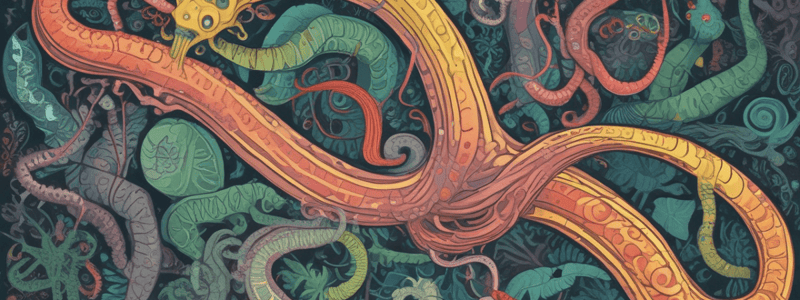Podcast
Questions and Answers
What is the most common mode of transmission for Trichuris trichiura?
What is the most common mode of transmission for Trichuris trichiura?
- Airborne transmission
- Mosquito bites
- Ingestion of eggs from contaminated soil or unwashed vegetables (correct)
- Person-to-person contact
What is a common symptom of moderate Trichuris trichiura burden?
What is a common symptom of moderate Trichuris trichiura burden?
- Chest congestion
- Joint pain
- Skin rash
- Stunting in growth (correct)
How many eggs can one female Trichuris trichiura worm produce per day?
How many eggs can one female Trichuris trichiura worm produce per day?
- 100 eggs
- 500 eggs
- 5,000 eggs (correct)
- 1,000 eggs
In heavy Trichuris trichiura burden, what complication can arise due to the colon being infested with worms?
In heavy Trichuris trichiura burden, what complication can arise due to the colon being infested with worms?
How is the diagnosis of Trichuris trichiura usually confirmed?
How is the diagnosis of Trichuris trichiura usually confirmed?
Which part of the body do adults of Trichuris trichiura primarily reside in?
Which part of the body do adults of Trichuris trichiura primarily reside in?
What skin symptoms are commonly associated with Strongyloides stercoralis infection?
What skin symptoms are commonly associated with Strongyloides stercoralis infection?
Which helminth infection is known for causing intestinal inflammation that can extend to both small and large intestines?
Which helminth infection is known for causing intestinal inflammation that can extend to both small and large intestines?
What symptoms are common in patients experiencing hyperinfection syndrome due to Strongyloides stercoralis?
What symptoms are common in patients experiencing hyperinfection syndrome due to Strongyloides stercoralis?
Which helminth has cylindrical bodies that taper at both ends and uses longitudinal muscular activity for movement in the host's intestinal lumen?
Which helminth has cylindrical bodies that taper at both ends and uses longitudinal muscular activity for movement in the host's intestinal lumen?
Which helminth infection is characterized by larvae that can disseminate to any organ in the body, causing profound symptoms and a high fatality rate in immunocompromised patients?
Which helminth infection is characterized by larvae that can disseminate to any organ in the body, causing profound symptoms and a high fatality rate in immunocompromised patients?
In Ascaris lumbricoides infection, what is the approximate length of an adult female worm?
In Ascaris lumbricoides infection, what is the approximate length of an adult female worm?
Which symptom is NOT typically associated with larval migration of Ascaris lumbricoides?
Which symptom is NOT typically associated with larval migration of Ascaris lumbricoides?
What is a possible consequence of heavy burden infection of Ascaris lumbricoides in the intestines?
What is a possible consequence of heavy burden infection of Ascaris lumbricoides in the intestines?
In the diagnosis of Ascaris lumbricoides, what is considered the gold-standard method for detection?
In the diagnosis of Ascaris lumbricoides, what is considered the gold-standard method for detection?
What is a characteristic feature of the Whipworm (Trichuris trichiura) adult female?
What is a characteristic feature of the Whipworm (Trichuris trichiura) adult female?
What is the approximate size of an undeveloped embryo of Trichuris trichiura?
What is the approximate size of an undeveloped embryo of Trichuris trichiura?
Which statement about the epidemiology of Trichuris trichiura is correct?
Which statement about the epidemiology of Trichuris trichiura is correct?
Flashcards are hidden until you start studying
Study Notes
Trichuris trichiura (Whipworm)
- Transmission: Fecal-oral, foodborne, ingestion of eggs from contaminated soil or unwashed/uncooked vegetables (human feces used as fertilizer)
- Lifespan: 1 year, 3 weeks
- Adults reside in cecum, attached by thin anterior end, with females producing 5,000 eggs/day
Symptoms
- Light Burden: Often asymptomatic
- Moderate Burden: Nausea, abdominal pain, diarrhea, stunting in growth, and eosinophilia
- Heavy Burden (>800 worms): Colon infestation, mucosal damage, blood loss, anemia, and prolapse of the colon
- Ulcerations provide enteric bacteria access to the bloodstream, increasing the risk of systemic infection
Diagnosis
- Fecal smear for the presence of eggs
- Colonoscopy
Trichinella spiralis (Trichina Worm)
- Adult female: 2.8-3.2 mm (length), ovoviviparous
- Larvae are released within the small intestine
- Autoinfection mechanisms: skin penetration, respiratory symptoms (dry cough, sore throat)
Symptoms
- Skin penetration: Pruritus, urticaria at the site of L3 entry
- Moderate-heavy burden: Abdominal pain, nausea/vomiting, diarrhea, intestinal inflammation
- Hyperinfection syndrome: Rhabditiform larvae disseminate to any organ, with profound diarrhea, malabsorption, and electrolyte abnormalities (86% fatality rate)
Soil-Transmitted Helminths
- Includes: Ascaris lumbricoides, Trichuris trichiura, Trichinella spiralis, Necator americanus, Ancylostoma duodenale, Strongyloides stercoralis
Ascaris lumbricoides (Roundworm)
- Unfertilized egg: 55μm x 40μm
- Adult female: 30cm (length), 3-6mm diameter
- Adult male: 15-30cm (length), 2-4mm diameter
- Cylindrical bodies that taper at both ends, with a chitinous layer of non-nucleated cuticle
Symptoms
- Larval migration: Fever, cough, wheezing, shortness of breath, and eosinophilia
- Adults in intestines (Light Burden/Asymptomatic): Often asymptomatic
- Adults in intestines (Heavy Burden): Abdominal pain, malabsorption, bowel obstruction
Diagnosis
- Gold-standard: Detection of knobby-coated eggs in stool
- Employ a concentration procedure for collecting eggs in light burden infection
- Adults can sometimes be found in stool
- Eosinophilia: High eosinophil count (white blood cells)
Trichuris trichiura (Whipworm)
- Epidemiology: 604-795 million people infected, 2-3 million infected in the US (rural areas of southeast US), affects up to 40% of the population in Brazil
- Eggs can survive up to 5 years in soil
- Most common in children 2-9 years
- High incidence in areas with poor sanitation practices
Studying That Suits You
Use AI to generate personalized quizzes and flashcards to suit your learning preferences.




